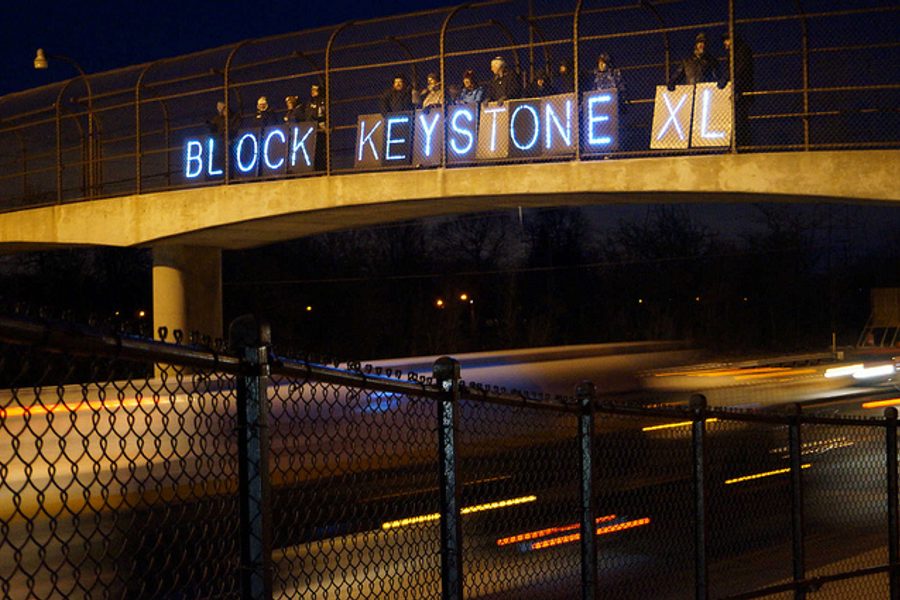Meet the Nebraskans Who Could Stop Keystone XL (Again)
But TransCanada is intervening in the process in its own way.
Kate Aronoff

Thanks to a State Department-issued presidential permit, Donald Trump has formally brought the Keystone XL pipeline back from the dead, a move he claims will lead to a “new era of American energy policy.” What Trump may not have factored in is the obstacle posed to that pipeline by the residents of a state that voted overwhelmingly for him in November: Nebraska.
As they have been before, Nebraskans are now in a position to disrupt both TransCanada’s and the administration’s plans, using many of the same tactics that defeated the proposed 1,700-mile long pipe the first time around. Their fight has been waged on multiple fronts over the last several years, balancing a legal strategy and fierce local opposition with a national resistance effort. With the pipeline back on the table, its opponents are revving up for another series of showdowns.
Taking a cue from the Dakota and Lakota Nation-led encampment pitched in opposition to the Dakota Access Pipeline last April, several tribes nationwide — including those whose land the project would pass through — are planning to set up camp all along Keystone XL’s route. As Standing Rock Sioux Chairman Dave Archambault II put it, “While we continue to fight DAPL in court, we will oppose Keystone on all fronts as well.”
“The Tribe has serious concerns about the safety and environmental impacts of the pipeline,” the Ponca Tribe said in a statement soon after the pipeline’s approval. “Both the Tribe’s present federally recognized territory and its traditional and aboriginal territory contain historic, cultural, sacred and archaeological sites and resources. The construction and operation of the Keystone XL Pipeline may disturb those sites, and may reveal and damage important Tribal cultural patrimony.”
Every route currently on the table for the Keystone extension would pass through Ponca territory in Nebraska, and the tribe has vowed to take on the pipeline. Among the venues where they plan to do that is the state’s Public Service Commission (PSC). Currently, the pipeline can’t legally be built through Nebraska, meaning that — even if the rest of the pipeline’s route were built — Transcanada wouldn’t be able to pump Tar Sands oil through it and down to the Gulf of Mexico. That decision on whether it eventually can now rests with the state’s five-member PSC.
Announcing the pipeline’s approval, Trump gestured vaguely to the barriers it could face, saying simply, “I’ll call Nebraska.” But its ultimate approval will require far more than a phone call.
“When Trump had his big moment on TV, he had no clue that there are still proceedings in Nebraska that had to occur,” Brian Jorde, an attorney at the Omaha-based Domina Law Group, told me by phone. “He has no power on the state law issues. They’re kind of clueless on a national level.”
Possible dangers
Over the next several months, the PSC will deliberate over whether to approve TransCanada’s application, which seeks to allow the Canadian oil giant to move ahead with pipeline construction through Nebraska, across Ponca land and that of several of the state’s homeowners — whether they want it there or not.
The PSC has 210 days from the date when the application was filed to make a ruling, meaning a final decision is likely to come in mid-September. From there, the decision could be extended by another five months for “just cause.” From March 30 through June 30, “interveners” — people approved by the PSC to officially weigh in on the process — can request information from TransCanada, according to Jorde. They will present that evidence along with live testimony to the PSC at a five-day public hearing, scheduled to begin August 7 in Lincoln.
Jorde, who has worked on Keystone-related cases with Domina for the last eight years, has been helping register interveners, 130 of whom have been approved so far.
Representatives from the Ponca tribe will be joined in their intervention by more than 90 landowners with properties that fall along the pipeline’s proposed route. In a move likely meant to chill opposition to the pipeline, Republican PSC member Tim Schram issued an order recently stating tribes, environmental groups and unions would have to combine their intervener statuses and choose one witness each to represent their issues. The landowners’ cases will remain separate.
Jorde represented many of the same landowners in a previous lawsuit, when — in 2011 — TransCanada first filed for eminent domain to run the pipeline through their property without consent. The company lost, and Jorde is still working to collect the legal fees TransCanada now owes to the landowners involved in the suit.
Among them is farmer and retired teacher Art Tanderup, who was a plaintiff in the first round of eminent domain lawsuits and is now registered as an intervener in the PSC process. He first got involved in fighting the pipeline after a TransCanada representative showed up at his door and offered him a hefty sum in exchange for the right to bury the pipeline under his farm. Researching the project after that visit brought Tanderup to Bold Nebraska, an anti-pipeline group. His opposition to Keystone XL is about much more than its effect on the planet, though he’s concerned about that, too.
Tanderup’s farm lies on the Nebraska Sandhills, and as a result has porous and sandy soil. “Basically it’s a sponge,” he tells In These Times, “and that sponge is the Ogalalla Aquifer.”
“Our well here at the farm that we drink water out of is 70 feet deep. Irrigation wells [for the Ogalalla Aquifer] are 120 feet deep. The pipeline would be 50 feet deep,” he said.
Any leak at all, then, has the potential to seep quickly down into his water source and that of potentially millions of other Nebraskans. And it’s not as if leaks are uncommon, either. According to the Pipeline and Hazardous Materials Safety Administration, there have been just short of 9,000 significant pipeline-related incidents in the United States, resulting in 548 deaths, 2,576 injuries and more than $8.5 billion in damages.
As a farmer, such leaks are especially risky to Tanderup’s property. Were one to happen, he says, “We would not be able to have drinking water here or water for farming. I do no-till farming, which builds up topsoil over time. I have been doing that for 13 years. A leak would ruin everything we’ve gained in those 13 years.”
Even if the pipeline remains leak-free, there are other dangers. Tar sands oil is able to flow through pipelines with the help of a chemical mixture. The friction between the two substances within the pipe creates considerable heat.
“In the wintertime that ground won’t freeze, and will create a haven for insects and other critters that will be able to multiply,” Tanderup says, and eat into his crops in warmer months. In addition to his participation in legal proceedings against TransCanada, Tanderup has also opened his farm up to serve as a site of anti-pipeline resistance, hosting music festivals and crop art creations. His land also lies along the Ponca Trail of Tears, and on Memorial Day he and several Ponca elders will participate in planting Ponca Sacred Corn there — in memoriam and as a show of defiance to TransCanada.
Landmark fight for the fossil fuel industry
Predictably, TransCanada is intervening in the process in its own way. Since the PSC is a majority-Republican body, one of the company’s main strategies has been to try and exert influence over the state’s GOP. Through an American subsidiary, the Columbia Pipeline Group, TransCanada poured $20,000 into Nebraska’s Republican Party on February 8. The sum adds to the $925,000 the company has contributed to lobbying efforts in that state over the last five years.
While its backers have accused environmentalists of “politicizing” the project, Keystone XL has become a landmark fight for the fossil fuel industry. The Koch Brothers are said to have a $100 billion stake in the project’s completion thanks to their holdings in the Alberta Tar Sands, and have spent at least $50 million lobbying Congress to push it through. As of 2013, the American Petroleum Institute, the main lobbying arm of the fossil fuel industry, had spent $22 million. The investment has bared some fruit for the industry in the most recent phase of the pipeline fate, with 33 of 49 of Nebraska’s state senators signing a letter urging the PSC to approve the project.
The reason behind the lobbying weight is that Keystone is now a more high-stakes proposition for oil majors than ever. As of late 2016, a full 35 percent of ExxonMobil’s liquid holdings sat in Canada’s oil sands, known as the “tar” sands because of the thickness of the oil extracted there. The composition of tar sands oil also makes it more difficult to get to market, meaning that Exxon is reliant on some cost-effective way to transport it down to refineries in Texas — namely, pipelines. Without one, those holdings become what are known as “stranded assets,” assets figured into the total value of oil and gas companies that are unable to be realized.
Exxon and other oil giants have more reasons to be worried than one pipeline’s approval, though. Keystone XL was dreamed up to serve an oil market that no longer exists. It’s relevance to today’s energy landscape remains an open question.
While Trump’s embrace of fossil fuels has certainly given it a shot in the arm, the price of oil remains well below its boom-time heights in 2014. Despite a recent rally, prices have floated around $50 per barrel since last spring. To put that in perspective, when the project was first being discussed in 2011, prices soared to as high as $122 per barrel — the highest they had been since before the Great Recession.
Because of low prices, no new oil sands projects have been approved since the market collapsed in 2014, save for three small pilot projects that were green lit after last year’s slight recovery. TransCanada’s continued insistence on completing the project now is essentially a multi-billion-dollar gamble on oil prices soaring more quickly and dramatically than oil industry analysts predict they will. (Extracting oil at all from Canada’s Tar Sands, a highly capital-intensive project, only became viable once prices rose above $70 in 2005.)
The project’s now-shaky economic foundations are part of the reason behind a national lawsuit being filed by six environmental groups. The Sierra Club, the Bold Alliance and others are contending that the State Department approved the pipeline based on a “woefully out-of-date” analysis about its economic and environmental impact, in violation of the National Environmental Policy Act (NEPA). The Indigenous Environmental Network and North Coast Rivers Alliance recently filed a similar suit seeking an injunction on any construction. And yet another suit, by several conservation groups and the Northern Cheyenne Native American Tribe of Montana, argues that the State Department’s approval of the Keystone XL constitutes a violation of the NEPA.
“They’re not doing us any favors by coming through Nebraska,” said Jorde. “We are physically and geographically in the way between Alberta and Houston.”
For the foreseeable future, Nebraskans — joined by allies from around the country — are going to use that placement to their advantage.

I hope you found this article important. Before you leave, I want to ask you to consider supporting our work with a donation. In These Times needs readers like you to help sustain our mission. We don’t depend on—or want—corporate advertising or deep-pocketed billionaires to fund our journalism. We’re supported by you, the reader, so we can focus on covering the issues that matter most to the progressive movement without fear or compromise.
Our work isn’t hidden behind a paywall because of people like you who support our journalism. We want to keep it that way. If you value the work we do and the movements we cover, please consider donating to In These Times.
Kate Aronoff is a staff writer at The New Republic and author of Overheated: How Capitalism Broke the Planet — And How We Fight Back. She is co-author of A Planet To Win: Why We Need a Green New Deal and co-editor of We Own the Future: Democratic Socialism—American Style. Follow her on Twitter @katearonoff.







